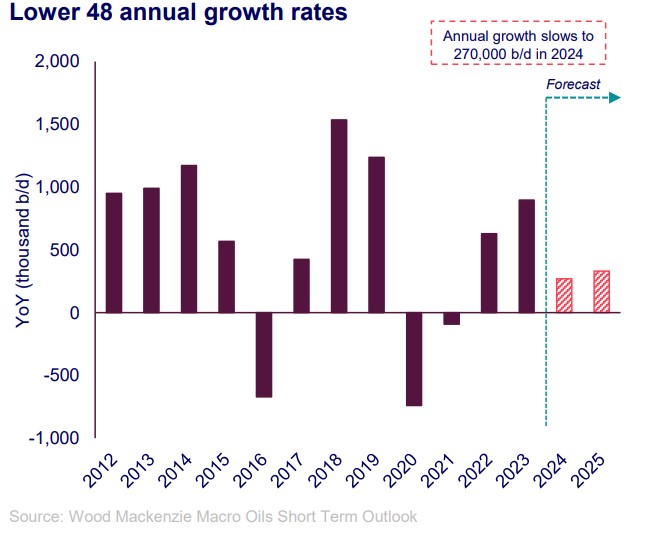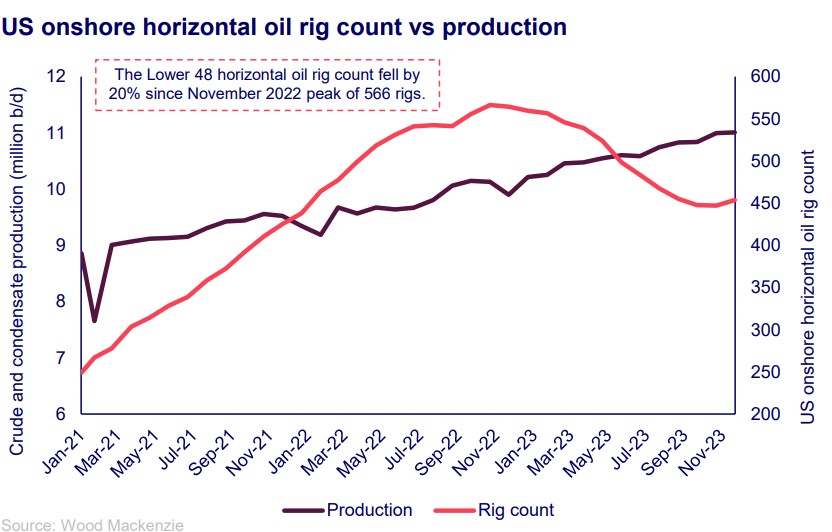Get in touch
-
Mark Thomtonmark.thomton@woodmac.com
+1 630 881 6885 -
Hla Myat Monhla.myatmon@woodmac.com
+65 8533 8860 -
Chris Bobachris.boba@woodmac.com
+44 7408 841129 -
Angélica Juárezangelica.juarez@woodmac.com
+5256 4171 1980 -
BIG PartnershipWoodMac@BigPartnership.co.uk
UK-based PR agency
After hitting new highs in 2023, US lower 48 oil production growth will begin to slow considerably in 2024 and beyond
Despite efficiency gains, falling rig counts will affect the market and future growth prospects
1 minute read
US Lower 48 oil production growth exceeded expectations in 2023, adding 900,000 barrels per day (b/d) despite inflationary pressures, private consolidation, and declining rig activity. However, the repercussions of these decisions will impact supply moving forward as the region is poised for much lower growth in 2024 and beyond, according to Wood Mackenzie.
In its report “Is the Lower 48 tight oil supply boom over?” Wood Mackenzie projects Lower 48 oil production to grow by 270,000 b/d in 2024 and another 330,000 b/d in 2025.
“The rig count declined throughout 2023, but the production impact will be felt in 2024,” said senior analyst Utkarsh Gupta. “This is mainly a function of the lag between spud and first production. Offsetting base declines gets increasingly difficult at higher production levels, resulting in more production needed just to keep production flat. Additionally, high-growth privates have been acquired, and cost inflation prompted remaining small privates to cut rigs. Public E&Ps will continue to tow single-digit growth plans.”

Lower 48 production eclipsed 11 million b/d in November last year, an all-time high. Efficiency gains were a major factor in this, as some Lower 48 E&Ps reported gains of 5% to 15% on drilling and 10% to 35% on completions for 2023 compared to 2022.
“This new all-time high milestone puts Lower 48 oil production in uncharted territory,” said principal analyst Nathan Nemeth. “The pre-Covid high watermark of 10.5 million b/d in December 2019 was exceeded in May 2023. Big efficiency gains allowed operators to maintain or exceed expectations for wells turned in line last year helping boost production with significantly fewer rigs. However, efficiency gains and associated well cost savings are not translating into more drilling activity like we’ve seen in the past. Instead, E&Ps have reiterated plans to return cash to shareholders.”

“Last year proved that it is too early to write off tight oil and the Permian remains a major growth engine,” said Nemeth. “As we move forward, Lower 48 production growth will be lower, but several factors could influence by how much, such as improving Permian well performance and further efficiency improvement. In a sustained higher price environment, the Lower 48 has proven able to add sizable volumes.”





